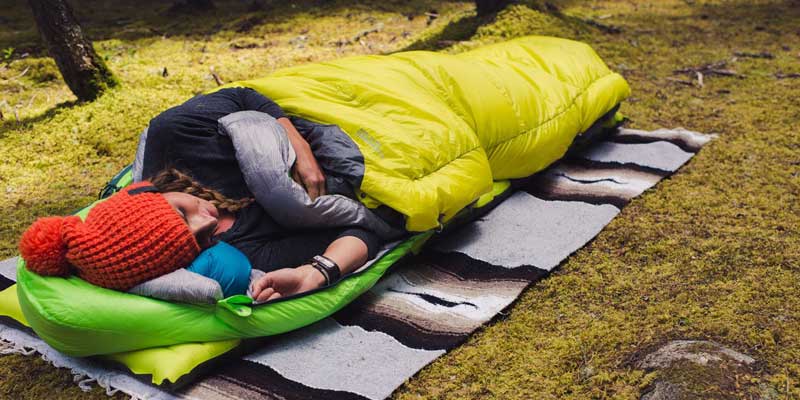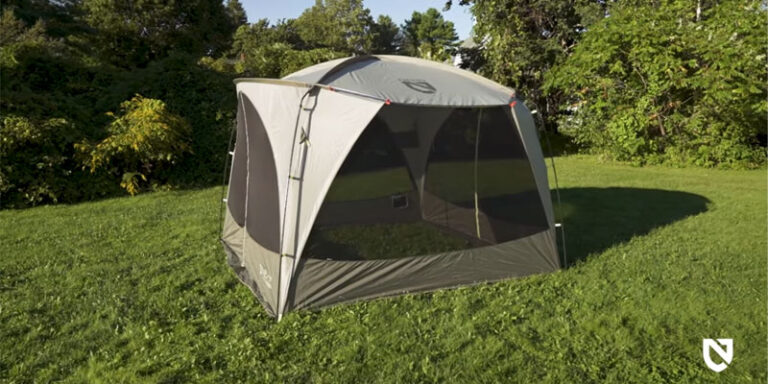Sleeping pads work fine for most people. But most pads just don’t work very well when it comes to side sleepers. People often complain about their sleeping pads being uncomfortable. And so, sleeping pads for side sleepers is one of the most asked questions among hikers. The reason this happens is that the weight distribution of a person sleeping on his side and a person sleeping on his back or chest is different. The weight of a person sleeping on his back is evenly distributed over a wide surface area.
But the weight of a side sleeper is concentrated on a narrow surface area pressing more firmly against the ground. The pressure is more intensely felt at the shoulder and hip joints. This results in a night of disturbed sleep and pain in these joints. Intense pressure against the ground also means less insulation and you also feel every pointy thing, rocks, and twigs, beneath you.
Well, here are the top picks for you if you like to sleep on your side.
1. Big Agnes Zoom UL
Thickness: 3.5 in.
Weight: 1 lb. 1 oz.
R-Value: 4.3
Best use: Backpacking
The Big Agnes Zoom UL Insulated sleeping pad is a top choice for ultralight backpackers. It is the lightest insulated air pad from Big Agnes, making it a great option for those who count every gram. With an R-value of 4.3, it is warm enough for three-season adventures. The pad is 3.25 inches thick, with 3.5-inch outer chambers that cradle you in the middle. This feature is especially useful for side sleepers who tend to move during the night. The O-beam internal construction reduces weight while improving stability. The pad is made from post-consumer recycled ripstop nylon, ensuring durability without harming the environment. Inside, an antimicrobial treatment prevents microorganism growth. Big Agnes also uses aviation-grade TPU lamination for extra durability. The pad comes with an inflation sack, a storage sack, a replacement valve seal, and repair patches.
Comfort and warmth are well balanced in this sleeping pad. Two layers of heat-reflective film help trap body heat without adding weight. The single-port, dual-function valve makes inflation and adjustments quick and easy. Unlike some thinner pads, the Zoom UL offers enough cushioning for a good night’s sleep. Compared to competitors like the Therm-a-Rest NeoAir XLite and Nemo Tensor All-Season, it holds its own. Side sleepers will appreciate the raised edges, which prevent rolling off. The pad packs down small and is easy to carry. However, for sleeping on snow or frozen ground, a foam pad is recommended for extra warmth. Each pad is individually tested at the factory to ensure top performance. If you need an ultralight pad that doesn’t sacrifice comfort, the Big Agnes Zoom UL is a solid choice.
What I like: Loftier side chambers help keep you stable throughout the night.
What I don’t: Not as warm as other pads with the same claimed R-value.
2. Sea to Summit Ether Light XT

Thickness: 4 in.
Weight: 15 oz.
R-Value: 3.8
Best use: UL Backpacking
Ether Light XT uses 4 inches of insulated cushioning to provide you with a comfortable and versatile pad for 3-season use. It features a multi-function valve and includes a pump sack that makes setup and takedown fast and easy. Instead of the baffled construction of many sleeping pads, this pad uses a pattern of dot welds to create hundreds of interconnected chambers called air-sprung cells.
The Ether Light XT pad uses loops of everyone’s favorite tongue-twisting synthetic material, thermoplastic polyurethane. Inside the pad, a mix of materials works to keep you warm. Exkin Platinum insulation is a metal material that reflects your radiant heat to you while promising to be less noisy than other such metalized films. The other material inside the pad, Thermolite forms a barrier between your body and the cold ground. This combined technology yields an R-value of 3.8 making the pad great for 3-season adventures.
By applying adhesive pillow lock strips to the pad, you can secure Aeros Pillow (not included) to the mat so they don’t sneak away in the middle of the night. This pad has a multi-function air valve. One configuration makes for easy inflation using a one-way valve that doesn’t allow air to leak back out as you inflate. Second, by pressing a button on the air valve you can let small controlled amounts of air out of the pad to fine-tune its firmness. A third configuration allows air to flow out quickly. This rapid and complete deflation also makes packing the pad easier.
What I like: Quiet, comfortable, and lightweight
What I don’t: Heavier than the NeoAir XLite below, expensive
3. NEMO Quasar 3D
Thickness: 3.5 in.
Weight: 1 lb. 9 oz.
R-Value: 3.3
Best use: Backpacking
The NEMO Quasar 3D Insulated Air Pad has quickly risen to prominence with its innovative features and commitment to sustainability. The newly added body-mapped 3D baffling is a game-changer. It provides a gentle cradle that keeps you centered on the pad throughout the night. The slightly elevated head baffle acts as a headboard. It ensures your camp pillow stays in place, enhancing overall sleep quality. This pad is not just about comfort; it’s a conscientious choice for environmentally-minded adventurers. What sets the Quasar 3D apart is its leap forward in sustainability. Constructed with bluesign® APPROVED materials, the 30D polyester ripstop is made from 100% post-consumer recycled materials. This not only aligns with eco-friendly values but also provides a durable and comfortable experience.
The inclusion of the Laylow™ zero-profile valve, combined with the Vortex™ pump sack, allows for swift inflation and deflation, and the ability to make micro-adjustments for personalized comfort. The insulated options, featuring a layer of 100% post-consumer recycled PrimaLoft®, further showcase NEMO’s commitment to balancing comfort, weight, and warmth. For those seeking a versatile sleeping pad that combines performance with sustainability, the NEMO Quasar 3D is an excellent choice for any adventure.
What I like: Balancing comfort, weight, and warmth.
What I don’t: Heavier than most air pads.
4. Big Agnes Divide
Thickness: 3.5 in.
Weight: 1 lb. 7 oz.
R-Value: 4
Best use: Backpacking
The Big Agnes Divide Insulated sleeping pad is a solid choice for casual backpackers and campers. It has a smooth, stable surface that keeps you comfortable. The larger outer tubes help cradle you in the middle, so you don’t roll off. At 3.25 inches thick, it provides good cushioning, especially for side sleepers. The pad uses Thermolite® insulation and a heat-reflective film to keep you warm. This helps trap body heat and prevent heat loss on chilly nights. The I-Beam construction reduces weight while keeping the pad stable. The material is durable, made from 70-denier recycled nylon, and has aviation-grade TPU lamination for strong seams. An antimicrobial treatment inside the pad prevents microorganism growth, adding to its longevity. Each pad is individually tested at the Big Agnes factory to ensure quality performance.
While the Divide Insulated is great for three-season use, it’s not the lightest option. At 1 pound 7 ounces, there are lighter choices for ultralight backpackers. The vertical baffles provide decent comfort but aren’t as plush as horizontal or boxed designs. Pads like the NeoAir XLite and Ether Light tend to be more supportive. However, it offers excellent value. New campers and recreational backpackers will find it reliable. Those needing an even lighter option can choose the non-insulated Divide, which costs less and has an R-value of 1.5, making it best for warm-weather trips.
What I like: Impressive warmth and plush padding at an affordable price.
What I don’t: Vertical baffles are not the most comfortable design.
5. Therm-a-Rest NeoAir XTherm NXT

Thickness: 3 in.
Weight: 1 lb.
R-Value: 7.3
Best use: Backpacking
The Therm-a-Rest NeoAir XTherm NXT is a stellar choice for adventurers seeking an ultralight and exceptionally warm sleeping pad for extreme backcountry conditions. With its impressive 7.3 R-value, this pad offers an outstanding warmth-to-weight ratio, making it ideal for frigid environments. The innovative Triangular Core Matrix™ construction and ThermaCapture technology not only contribute to its high R-value but also manage to reduce the overall weight by over 2 ounces compared to its predecessor. This combination of warmth, durability, and weight savings is a game-changer for those pushing the limits of cold-weather pursuits.
The thoughtful design features of the NeoAir XTherm NXT further enhance its appeal. The 70-denier nylon on the bottom ensures longevity, withstanding the rigors of extended expeditions, while the 30-denier ripstop nylon on top keeps the pad light and easily packable. The 3-inch thickness and horizontal baffled structure provide premium comfort in the backcountry without compromising weight. The WingLock™ valve adds convenience with fast one-way inflation, rapid deflation, and the ability to make micro-adjustments for personalized comfort. The inclusion of a pump sack, stuff sack, and field repair kit adds practicality to an already impressive sleeping pad, making the Therm-a-Rest NeoAir XTherm NXT a top choice for adventurers seeking a high-performance, cold-weather sleeping solution.
What I like: Exceptionally warm for its weight.
What I don’t: Slippery.
6. Therm-a-Rest NeoAir Xlite NXT

Thickness: 3 in.
Weight: 13 oz.
R-Value: 4.5
Best use: UL Backpacking
The Therm-a-Rest NeoAir XLite NXT is a remarkable upgrade in the realm of ultralight backpacking gear. The enhanced design, featuring a quieter and thicker build with reduced bulk, showcases Therm-a-Rest’s commitment to optimizing comfort without compromising portability. The pad’s 3 inches (7.6 cm) of thickness provides premium backcountry comfort, making it an excellent choice for those who prioritize a good night’s sleep in the wilderness. The innovative internal construction incorporates ThermaCapture™ technology and a Triangular Core Matrix™, effectively radiating body heat and minimizing convective heat loss.
With a 4.5 R-value, the NeoAir XLite NXT ensures year-round warmth and versatility. The WingLock™ valve facilitates quick one-way inflation and rapid deflation, and its ability to easily purge air while in use allows for micro-adjustments for personalized comfort. Additionally, the ultralight construction and low-bulk materials enable the sleeping pad to pack down to the size of a conventional 1 L water bottle, providing backpackers with a space-saving solution. The inclusion of a pump sack, stuff sack, and field repair kit further enhances the overall value of this top-tier sleeping pad for outdoor enthusiasts seeking a balance between weight, comfort, and durability.
What I like: Packs down to the size of a conventional 1 L water bottle.
What I don’t: The pump sack is difficult to connect and disconnect.
7. NEMO Tensor All-Season
Thickness: 3.5 in.
Weight: 1 lb.
R-Value: 5.4
Best use: Backpacking
The NEMO Tensor All-Season sleeping pad is a great choice for year-round camping. With an R-value of 5.4, it provides solid warmth even in freezing temperatures. The Spaceframe™ baffle design gives stable support and just the right amount of flexibility. Inside, two layers of Thermal Mirror™ film reflect body heat efficiently. Unlike many insulated pads, this one is quiet, thanks to its floating construction. The 3.5-inch loft offers excellent cushioning. The top is made of 20-denier nylon, while the bottom has tougher 40-denier nylon for better durability. The pad feels well-made, though long-term durability is still a question. It’s very lightweight and packs down small, making it easy to carry.
Inflating the pad is quick and effortless with the included Vortex™ pump sack. It took me only four breaths using the right technique. The Laylow™ valve is well-designed, allowing precise inflation adjustments. I tested it on a cold concrete floor and immediately felt warmth radiating back. Repacking it was simple, and it fit easily into its stuff sack. I found it very comfortable for side sleeping but slightly less so on my back. The only concern is its durability, so I plan to carry a backup pad. Despite that, it seems like an excellent option for four-season camping.
What I like: No loud crinkling noise like many insulated air pads.
What I don’t: Back sleepers may find it less comfortable
8. Big Agnes Rapide SL

Thickness: 3.5 in.
Weight: 1 lb. 3 oz.
R-Value: 4.2
Best use: Backpacking
The Big Agnes Rapide SL Insulated sleeping pad proves to be a top-notch choice for those seeking a combination of comfort, insulation, and portability in a compact package. The upgraded insulation not only enhances warmth but also manages to reduce overall weight, making it a superb option for three-season adventures. The offset I-Beam construction is a standout feature, effectively minimizing weight while ensuring consistent stability and comfort. With a commendable R-value of 4.8, this superlight air chamber pad stands out for its ability to provide reliable warmth through varying temperatures.
Measuring 3.5 inches thick with larger outer chambers at 4.25 inches, the pad offers a cradling and cushioned sleeping surface, ensuring a restful night’s sleep even in challenging terrains. The durable, superlight nylon double ripstop material adds to the pad’s resilience, while the quilted top enhances the overall sleeping experience. The inclusion of the Pumphouse high volume inflation sack not only simplifies the inflation process but also exemplifies the attention to detail in providing a comprehensive package for outdoor enthusiasts. Whether you’re a seasoned backpacker or a casual camper, the Big Agnes Rapide SL Insulated sleeping pad stands as a testament to superior performance, packability, and durability for any adventure.
What I like: The pad packs down smaller than its predecessor and is exceptionally lightweight.
What I don’t: Expensive for an air pad.
9. Exped Ultra 7R

Thickness: 3.5 in.
Weight: 1 lb. 6 oz.
R-Value: 7.1
Best use: Backpacking
The Exped Ultra 7R sleeping pad stands out as an exceptional choice for backpackers venturing into the harshest conditions. With a robust 700-fill-power down insulation and an impressive 7.1 R-value, this sleeping pad is tailor-made for extreme cold weather and icy terrains. Weighing in at a mere 1 lb. 6 oz. in size Medium, it’s remarkably lightweight and easily portable, making it an ideal companion for remote excursions. Crafted with precision, the 20-denier, 100% recycled polyester fabric not only contributes to the pad’s feather-light quality but also boasts a nonslip finish for enhanced stability.
The 3.5-inch thickness of the mat ensures a comfortable night’s sleep for side sleepers. The innovative design features internal hydrolysis-resistant laminate, which shields the pad from bacteria and moisture, prolonging its lifespan. The internal welded baffles create a cushioned and stable sleep surface, preventing cold spots without compromising on weight. The Exped Comfort Cradle, formed by oversized outer chambers, helps keep users centered and secure on the pad. The inclusion of a Schnozzel pump bag for inflation, a stuff sack for transportation, and a comprehensive repair kit with adhesive and fabric patches further solidify the Exped Ultra 7R’s position as a top-tier choice for those seeking the utmost insulation in extreme cold conditions.
What I like: Boasts a 700-fill-power-down insulation and an impressive 7.1 R-value.
What I don’t: Difficult to repack.
10. Nemo Tensor Trail
Thickness: 3.5 in.
Weight: 13.9 oz.
R-Value: 2.8
Best use: UL Backpacking
The NEMO Tensor Trail Ultralight Insulated sleeping pad is a great choice for three-season camping. It is lightweight and compact, making it easy to carry on backpacking trips. The pad has a 2.8 R-value, which helps keep you warm from spring to fall. Inside, the Spaceframe™ baffle design provides a stable and comfortable sleeping surface. This design prevents the pad from feeling too firm or too soft. A floating layer of Thermal Mirror™ film reflects body heat without making loud crinkling noises. This feature makes the Tensor Trail quieter than many other insulated sleeping pads.
Durability is another strong point of this pad. The top layer is made of 20-denier nylon, while the bottom has tougher 40-denier nylon. This protects against punctures and wear. The Laylow™ valve allows precise inflation control, even in cold weather. The Vortex™ pump sack makes inflation quick and easy while reducing moisture buildup. With 3.5 inches of loft, the pad provides great support for a restful sleep. The Tensor Trail also uses bluesign®-approved fabrics, ensuring sustainability without sacrificing performance. It comes in different sizes to fit various sleep systems. Overall, this pad balances warmth, comfort, and weight, making it ideal for backpackers who need reliable gear.
What I like: Large sleeping area, doesn’t make noise
What I don’t: The valves can be a little difficult to open.
Best Sleeping Pads for Side Sleepers: Summary
| PAD | THICKNESS | WEIGHT | R-VALUE | BEST USE |
|---|---|---|---|---|
| Big Agnes Zoom UL | 3.5 in. | 1 lb. 1 oz. | 4.3 | Backpacking |
| Sea to Summit Ether Light XT | 4 in. | 15 oz. | 3.8 | UL Backpacking |
| NEMO Quasar 3D | 3.5 in. | 1 lb. 9 oz. | 3.3 | Backpacking |
| Big Agnes Divide | 3.5 in. | 1 lb. 7 oz. | 4 | Backpacking |
| Therm-a-Rest NeoAir XTherm NXT | 3 in. | 1 lb. | 7.3 | Backpacking |
| Therm-a-Rest NeoAir Xlite NXT | 3 in. | 13 oz. | 4.5 | UL Backpacking |
| NEMO Tensor All-Season | 3.5 in. | 1 lb. | 5.4 | Backpacking |
| Big Agnes Rapide SL | 3.5 in. | 1 lb. 3 oz. | 4.2 | Backpacking |
| Exped Ultra 7R | 3.5 in. | 1 lb. 6 oz. | 7.1 | Backpacking |
| Nemo Tensor Trail | 3.5 in. | 13.9 oz. | 2.8 | UL Backpacking |
Sleeping Pad Considerations for Side Sleepers
Although most sleeping pads will work fine for side sleepers, there are still some things you should consider before buying a sleeping pad that will prevent you from making the wrong choice.
Thickness
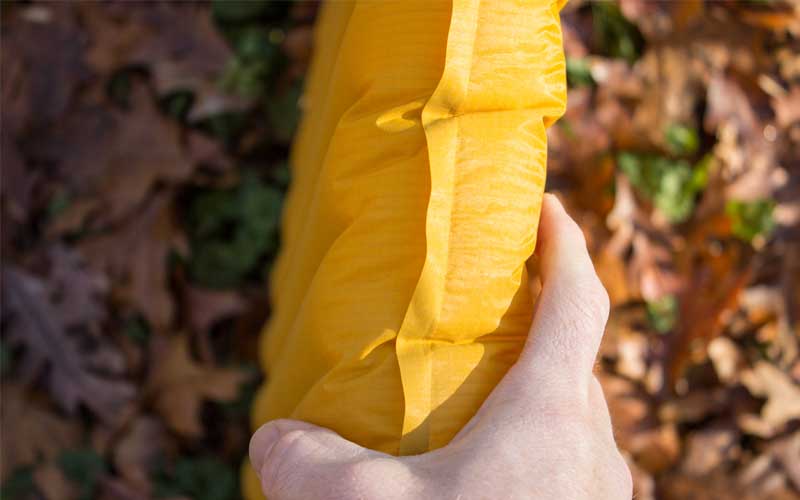
The most important thing to consider is the thickness of the pad. As mentioned above, the weight is concentrated on a narrow base. This makes the shoulder and the hip joint, a pressure point. Usually, pads with a thickness of 3 or more inches are recommended for side sleepers so that they provide adequate protection against the ground.
Durability

Durability matters a lot. Since your body will be exerting the force on a small surface area, your pad should be able to withstand pointy rocks and twigs on the ground. You wouldn’t want to be using your repair kit now and then. Choose a pad with a strong fabric.
Weight and Packing Size
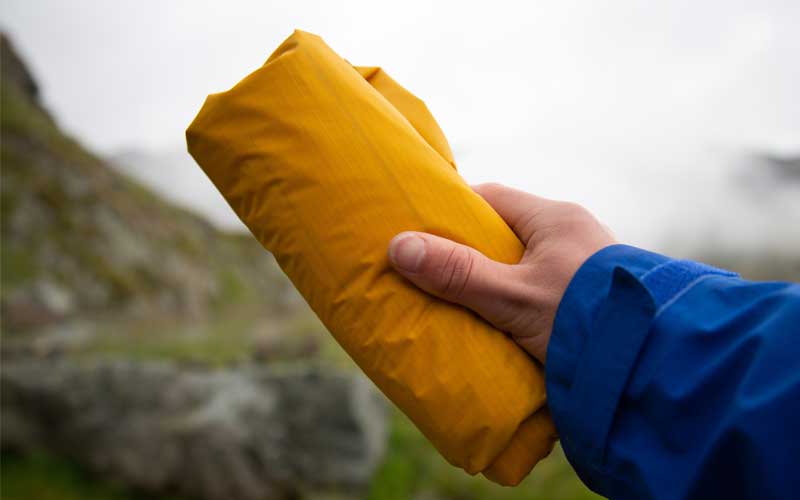
The weight of the pad matters as you wouldn’t want to drag extra weight with you, especially when you are packing ultralight. Similarly, the pad should also be packed small and shouldn’t take up much space in your backpack for efficient space management.
Shape and Size
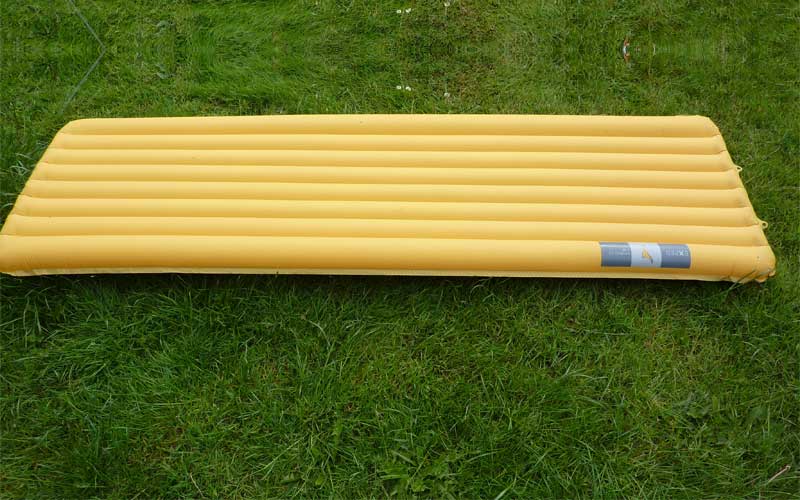
Usually, the width of the pad doesn’t matter for a side sleeper. But the length of the pad matters. Make sure to choose the size that compensates your body completely. If you are an active sleeper and tend to roll around in your sleep, then you should have raised edges to keep you centered.
Warmth and Comfort
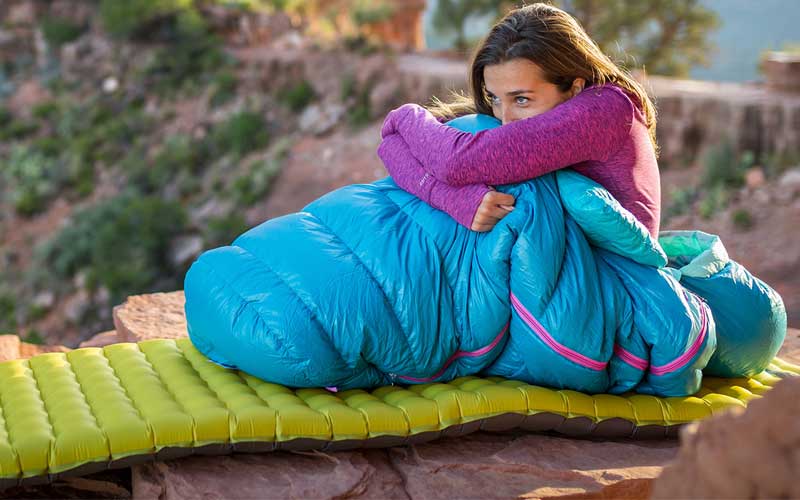
How much insulation your pad should provide depends upon the weather of your outdoor destination. For colder weather, pads with higher R-value should be chosen and vice versa. Your pad should also provide adequate comfort for a good night’s sleep. If you are a light sleeper, then you should keep in mind that your pad shouldn’t make much noise when you move on it.
Conclusion
The right sleeping pad provides the necessary support and comfort to alleviate pressure points and promote proper spine alignment. After exploring various options, it’s clear that the key factors include thickness, material, and design tailored to the unique needs of side sleepers. Whether you prefer memory foam, air pads, or hybrid models, choosing a sleeping pad that caters to your sleeping style can make a significant difference in your overall sleep quality. Sweet dreams begin with the right sleeping pad beneath you. It ensures a cozy and restful night for all those who favor sleeping on their sides.
